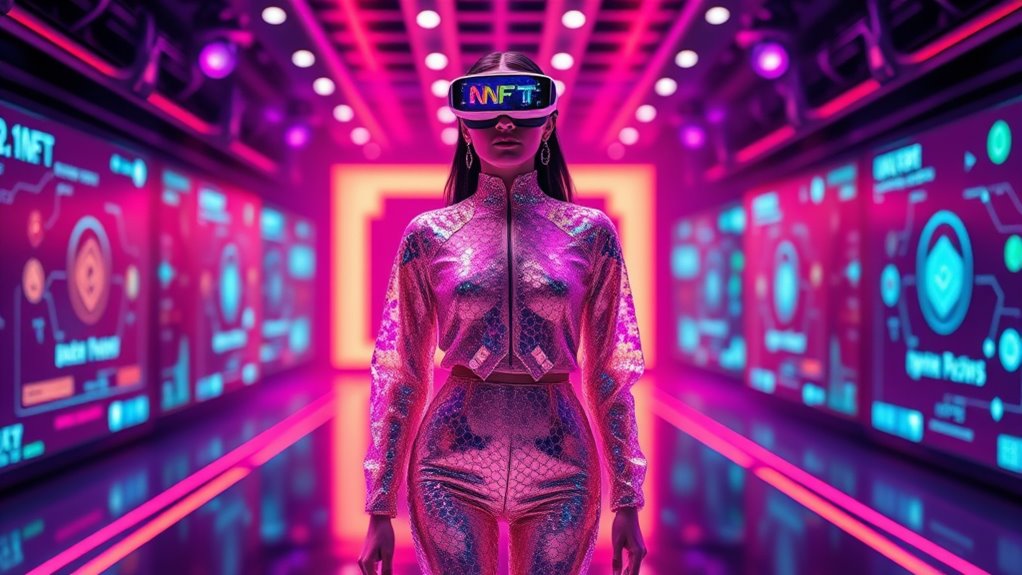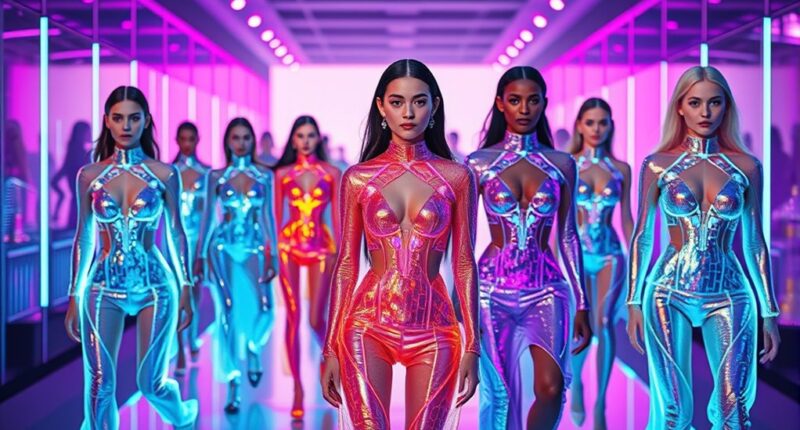Wear-to-earn models are reshaping how influencers engage with digital fashion by rewarding active participation and ownership of NFTs, rather than relying solely on brand deals. This shift allows you to build your virtual wardrobe, showcase limited-edition digital styles, and earn rewards as you participate in virtual events. As this movement grows, it’s changing the influencer landscape entirely—if you want to discover how it continues to evolve, keep exploring further.
Key Takeaways
- Wear-to-earn models incentivize user engagement through earning rewards, shifting focus from traditional influencer brand deals.
- Digital fashion NFTs enable individuals to build personal virtual wardrobes, reducing reliance on influencer-led promotion.
- Influencers are increasingly promoting digital assets and NFTs, blending traditional influence with new digital economies.
- The decentralized nature of wear-to-earn platforms fosters direct consumer participation, potentially diminishing influencer gatekeeping.
- The immersive and interactive experiences of digital fashion may prioritize user ownership and participation over influencer endorsements.

Have you ever wondered how digital technology is transforming the fashion industry? It’s no longer just about fabrics and runway shows; now, it’s about pixels, virtual experiences, and digital assets. Digital fashion NFTs are reshaping how brands connect with consumers and how influencers operate. Imagine attending a virtual runway show where designs are showcased through stunning digital displays, accessible from anywhere in the world. These virtual runways aren’t confined by physical space or logistics, allowing brands to push creative boundaries and reach global audiences instantly. As you explore this space, collectible avatars come into focus—they’re personalized digital representations that can wear exclusive fashion NFTs, serving as your unique virtual identity. These avatars can attend virtual events, showcase your style, and even participate in digital fashion shows, blurring the line between real and virtual fashion worlds.
In this emerging landscape, fashion brands are experimenting with digital collectibles that go beyond traditional clothing. Collectible avatars aren’t just static images; they’re interactive, customizable, and often linked to limited-edition NFTs. These assets can be bought, sold, or traded, creating a new economy centered around digital fashion. You might own a digital avatar dressed in a designer’s latest NFT collection, which you can display on social media or use in virtual environments. This personalization fosters a sense of ownership and exclusivity, making digital fashion more appealing than ever. Virtual runways showcase these digital designs on animated, 3D models, allowing audiences to experience fashion in an immersive way. Instead of waiting for physical shows, you can experience cutting-edge fashion from your device, feeling like you’re part of the future of style. Additionally, the 19th-century industrial and Victorian-inspired designs heavily influence some digital fashion aesthetics, blending historical motifs with modern technology.
As the digital fashion world expands, the importance of collectible avatars and virtual runways grows. They serve as platforms where designers and consumers converge in innovative ways. Influencers are shifting their focus from traditional brand deals to digital assets, promoting NFTs and virtual fashion items to their followers. This shift could redefine influencer marketing, emphasizing digital ownership and virtual style statements over physical endorsements. With wear‑to‑earn models emerging, where users earn rewards by engaging with digital fashion, the influence of traditional influencer deals might diminish. Instead of simply promoting brands, you could be actively participating in the digital fashion economy—buying, selling, and showcasing NFTs that represent your style. This creates a more interactive, decentralized, and potentially lucrative fashion experience that puts you at the center of the digital wardrobe revolution.
Frequently Asked Questions
How Secure Are Digital Fashion NFTS From Hacking?
When considering how secure digital fashion NFTs are from hacking, you should know that blockchain security generally offers strong protection, but hacking vulnerabilities still exist. You’re at risk if you don’t use secure wallets or fall for scams. Always enable two-factor authentication and keep your private keys safe. While blockchain tech is tough to crack, no system is completely immune, so stay vigilant to protect your valuable digital assets.
Can NFTS Be Customized for Individual Style Preferences?
You can definitely customize NFTs to match your style preferences through various personalization options. Many platforms offer style customization, allowing you to modify colors, patterns, or accessories to make each digital fashion NFT uniquely yours. This level of personalization enhances your digital wardrobe, giving you more control over your virtual look. As technology advances, expect even more innovative ways to tailor NFTs to reflect your individual style preferences.
What Is the Environmental Impact of Creating and Trading NFTS?
When creating and trading NFTs, you should consider their environmental impact. The process often involves high energy consumption due to blockchain technology, which can hinder sustainable production. As a user, you might worry about the carbon footprint, but some platforms are adopting greener practices to reduce energy use. Being aware of these efforts helps you support more eco-friendly NFT markets and promotes sustainable digital transactions.
Are Digital Fashion NFTS Legally Protected as Intellectual Property?
You might wonder if digital fashion NFTs are legally protected as intellectual property. While they can be secured through copyright or trademark laws, the legal protections depend on jurisdiction and how the rights are established. As a creator or buyer, you should understand that NFTs don’t automatically grant ownership of the underlying intellectual property. Always verify the rights conveyed and consult legal experts to guarantee your rights are protected.
How Do Wear‑To‑Earn Models Ensure Fair Compensation for Creators?
Wear-to-earn models guarantee fair compensation for creators by implementing transparent systems that prioritize creator royalties and fair payment. You can track earnings directly through blockchain technology, which guarantees creators receive a percentage of resale or usage. This setup fosters trust and incentivizes ongoing innovation, making sure creators are fairly compensated for their work. By emphasizing transparent royalty structures, wear-to-earn models aim to replace traditional influencer deals with more equitable, sustainable income streams.
Conclusion
As you explore the rise of digital fashion NFTs, it’s clear they’re reshaping how you engage with style and influence. Wear-to-earn models give you a chance to earn while showcasing virtual outfits, potentially reducing your reliance on traditional influencer deals. While NFTs open new doors, they also bring questions about ownership and authenticity. Ultimately, you’ll need to decide how these innovations fit into your digital wardrobe and influencer journey moving forward.








